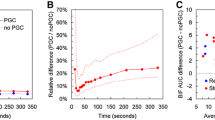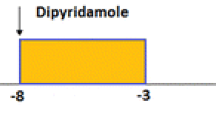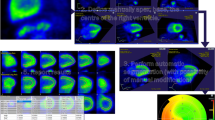Abstract
Objectives
Recent technological improvements to PET imaging equipment combined with the availability of software optimized to calculate regional myocardial blood flow (MBF) and myocardial flow reserve (MFR) create a paradigm shifting opportunity to provide new clinically relevant quantitative information to cardiologists. However, clinical interpretation of the MBF and MFR is entirely dependent upon knowledge of MBF and MFR values in normal populations and subpopulations. This work reports Rb-82-based MBF and MFR measurements for a series of 49 verified cardiovascularly normal subjects as a preliminary baseline for future clinical studies.
Methods
Forty-nine subjects (24F/25M, ages 41-69) with low probability for coronary artery disease and with normal exercise stress test were included. These subjects underwent rest/dipyridamole stress Rb-82 myocardial perfusion imaging using standard clinical techniques (40 mCi injection, 6-minute acquisition) using a Siemens Biograph 40 PET/CT scanner with high count rate detector option. List mode data was rehistogrammed into 26 dynamic frames (12 × 5 seconds, 6 × 10 seconds, 4 × 20 seconds, 4 × 40 seconds). Cardiac images were processed, and MBF and MFR calculated using Siemens syngo MBF, PMOD, and FlowQuant software using a single compartment Rb-82 model.
Results
Global myocardial blood flow under pharmacological stress for the 24 females as measured by PMOD, syngo MBF, and FlowQuant were 3.10 ± 0.72, 2.80 ± 0.66, and 2.60 ± 0.63 mL·minute−1·g−1, and for the 25 males was 2.60 ± 0.84, 2.33 ± 0.75, 2.15 ± 0.62 mL·minute−1·g−1, respectively. Rest flows for PMOD, syngo MBF, and FlowQuant averaged 1.32 ± 0.42, 1.20 ± 0.33, and 1.06 ± 0.38 mL·minute−1·g−1 for the female subjects, and 1.12 ± 0.29, 0.90 ± 0.26, and 0.85 ± 0.24 mL·minute−1·g−1 for the males. Myocardial flow reserves for PMOD, syngo MBF, and FlowQuant for the female normals were calculated to be 2.50 ± 0.80, 2.53 ± 0.67, 2.71 ± 0.90, and 2.50 ± 1.19, 2.85 ± 1.19, 2.94 ± 1.31 mL·minute−1·g−1 for males.
Conclusion
Quantitative normal MBF and MFR values averaged for age and sex have been compiled for three commercial pharmacokinetic software packages. The current collection of data consisting of 49 subjects resulted in several statistically significant conclusions that support the need for a software specific, age, and sex-matched database to aid in interpretation of quantitative clinical myocardial perfusion studies.







Similar content being viewed by others
References
Goldstein RA. Rubidium-82 kinetics after coronary occlusion: Temporal relation of net myocardial accumulation and viability in open-chested dogs. J Nucl Med 1986;27(9):1456-61.
Herrero P, Markham J, Shelton ME, Weinheimer CJ, Bergmann SR. Noninvasive quantification of regional myocardial perfusion with rubidium-82 and positron emission tomography. Exploration of a mathematical model. Circulation 1990;82(4):1377-86.
Huang SC, Williams BA, Williams BA, Krivokapich J, Araujo L, Araujo L, et al. Rabbit myocardial 82Rb kinetics and a compartmental model for blood flow estimation. Am J Physiol 1989;256(4 Pt 2):H1156-64.
Krivokapich J, Smith GT, Huang SC, Hoffman EJ, Ratib O, Phelps ME, et al. 13N ammonia myocardial imaging at rest and with exercise in normal volunteers. Quantification of absolute myocardial perfusion with dynamic positron emission tomography. Circulation 1989;80(5):1328-37.
Yoshida K, Yoshida K, Mullani N, Mullani N, Gould KL. Coronary flow and flow reserve by PET simplified for clinical applications using rubidium-82 or nitrogen-13-ammonia. J Nucl Med 1996;37(10):1701-12.
Ziadi MC, Beanlands RSB. The clinical utility of assessing myocardial blood flow using positron emission tomography. J Nucl Cardiol 2010;17(4):571-81.
Klein R, Beanlands RSB, deKemp RA. Quantification of myocardial blood flow and flow reserve: Technical aspects. J Nucl Cardiol 2010;17(4):555-70.
Lortie M, Beanlands R, Yoshinaga K, Klein R. Quantification of myocardial blood flow with 82Rb dynamic PET imaging. Eur J Med Mol Imaging 2007;34:1765-74.
Wisenberg G, Schelbert HR, Hoffman EJ, Phelps ME, Robinson GD Jr, Selin CE, et al. In vivo quantitation of regional myocardial blood flow by positron-emission computed tomography. Circulation 1981;63(6):1248-58.
Nakazato R, Berman DS, Dey D, Le Meunier L, Hayes SW, Fermin JS, et al. Automated quantitative Rb-82 3D PET/CT myocardial perfusion imaging: Normal limits and correlation with invasive coronary angiography. J Nucl Cardiol 2012;19(2):265-76.
El Fakhri G, Kardan A, Sitek A, Dorbala S. Reproducibility and accuracy of quantitative myocardial blood flow assessment with 82Rb PET: Comparison with 13N-ammonia PET. J Nucl Med 2009;50:1062-71.
Kaufmann PA, Gnecchi-Ruscone T. Assessment of the reproducibility of baseline and hyperemic myocardial blood flow measurements with 15O-labeled water and PET. J Nucl Med 1999;40:1848-56.
Knešaurek K, Machac J, Zhang Z. Repeatability of regional myocardial blood flow calculation in 82Rb PET imaging. BMC Med Phys 2009;9(1):2.
Manabe O, Yoshinaga K, Katoh C, Naya M, deKemp RA, Tamaki N. Repeatability of rest and hyperemic myocardial blood flow measurements with 82Rb dynamic PET. J Nucl Med 2008;50(1):68-71.
Prior JO, Allenbach G, Valenta I, Kosinski M, Burger C, Verdun FR, et al. Quantification of myocardial blood flow with 82Rb positron emission tomography: Clinical validation with 15O-water. Eur J Nucl Med Mol Imaging 2012;39(6):1037-47.
Renaud JM, Lortie M, DaSilva J. Quantification of the normal range of myocardial blood flow and flow reserve with 82-rubidium versus 13-N-ammonia PET. IEEE Nucl Sci Symp Conf Rec 2007;2007:3141-5.
Beanlands RSB, Ziadi MC, Williams K. Quantification of myocardial flow reserve using positron emission imaging. J Clin Use 2009;54(2):157-9.
Chareonthaitawee P, Kaufmann PA, Rimoldi O, Camici PG. Heterogeneity of resting and hyperemic myocardial blood flow in healthy humans. Cardiovasc Res 2001;50(1):151-61.
Czernin J, Muller P, Chan S, Brunken RC, Porenta G, Krivokapich J, et al. Influence of age and hemodynamics on myocardial blood flow and flow reserve. Circulation 1993;88(1):62-9.
Dekemp RA, Declerck J, Klein R, Pan X-B, Nakazato R, Tonge C, et al. Multisoftware reproducibility study of stress and rest myocardial blood flow assessed with 3D dynamic PET/CT and a 1-tissue-compartment model of 82Rb kinetics. J Nucl Med 2013;54(4):571-7.
Rajaram M, Tahari AK, Lee AH, Lodge MA, Tsui B, Nekolla S, et al. Cardiac PET/CT misregistration causes significant changes in estimated myocardial blood flow. J Nucl Med 2013;54(1):50-4.
Esteves FP, Nye JA, Khan A, Folks RD, Halkar RK, Garcia EV, et al. Prompt-gamma compensation in Rb-82 myocardial perfusion 3D PET/CT. J Nucl Cardiol 2010;17(2):247-53.
Martin CC, Christian BT, Satter MR, Nickerson LDH, Nickles RJ. Quantitative PET with positron emitters that emit prompt gamma rays. IEEE Trans Med Imaging 1995;14(4):681-7.
Fukushima K, Javadi MS, Higuchi T, Lautamaki R, Merrill J, Nekolla SG, et al. Prediction of short-term cardiovascular events using quantification of global myocardial flow reserve in patients referred for clinical 82Rb PET perfusion imaging. J Nucl Med 2011;52(5):726-32.
Tio RA, Dabeshlim A, Siebelink HMJ, de Sutter J, Hillege HL, Zeebregts CJ, et al. Comparison between the prognostic value of left ventricular function and myocardial perfusion reserve in patients with ischemic heart disease. J Nucl Med 2009;50(2):214-9.
Fiechter M, Gebhard C, Ghadri JR, Fuchs TA, Pazhenkottil AP, Nkoulou RN, et al. Myocardial perfusion imaging with 13N-ammonia PET is a strong predictor for outcome. Int J Cardiol 2013;167(3):1023-6.
Ziadi MC, Dekemp RA, Williams KA, Guo A, Chow BJW, Renaud JM, et al. Impaired myocardial flow reserve on rubidium-82 positron emission tomography imaging predicts adverse outcomes in patients assessed for myocardial ischemia. J Am Coll Cardiol 2011;58(7):740-8.
Saraste A, Kajander S, Han C, Nesterov SV, Knuuti J. PET: Is myocardial flow quantification a clinical reality? J Nucl Cardiol 2012;19(5):1044-59.
Diamond GA, Forrester JS. Analysis of probability as an aid in the clinical diagnosis of coronary-artery disease. N Engl J Med 1979;300(24):1350-8.
Pan X, Schindler T, Ratib O, Nekolla S, Declerck J. Effect of reorientation on myocardial blood flow estimation from dynamic 13NH3PET imaging. In: 2009 IEEE Nuclear Science Symposium Conference Record (NSS/MIC). Orlando: IEEE; 2009.
Pan X, Declerck J. White paper: Validation syngo.PET myocardial blood flow. Hoffman Estates: Siemens Medical Solutions; 2011. p. 1-17.
Klein R, Renaud JM, Ziadi MC, Thorn SL, Adler A, Beanlands RS, et al. Intra- and inter-operator repeatability of myocardial blood flow and myocardial flow reserve measurements using rubidium-82 PET and a highly automated analysis program. J Nucl Cardiol 2010;17(4):600-16.
Disclosure
First Author (Sunderland) received research funding from Siemens Medical Solutions for the performance of the research presented. Drs. Pan and Declerck are employees of Siemens Molecular Imaging, the IP holders for one of the pieces of software tested and presented. Dr. Pan was involved in early processing of the data for syngo MBF in earlier software versions and provided technical modeling support. Both Drs. Pan and Declerck were involved in editing the manuscript.
Author information
Authors and Affiliations
Corresponding author
Additional information
Funding
This project was funded, in part, by Siemens Molecular Imaging.
See related editorial, doi: 10.1007/s12350-014-0007-1.
Rights and permissions
About this article
Cite this article
Sunderland, J.J., Pan, XB., Declerck, J. et al. Dependency of cardiac rubidium-82 imaging quantitative measures on age, gender, vascular territory, and software in a cardiovascular normal population. J. Nucl. Cardiol. 22, 72–84 (2015). https://doi.org/10.1007/s12350-014-9920-6
Received:
Accepted:
Published:
Issue Date:
DOI: https://doi.org/10.1007/s12350-014-9920-6




